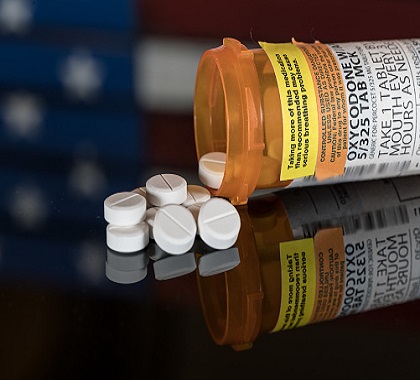A team of 20 researchers at Penn State University have released a series of studies in the American Journal of Managed Care examining the financial burden borne by states because of the opioid epidemic. One study, “The Economic Burden of the Opioid Epidemic on States: The Case of Medicaid,” examined data from 17 states from 1999 to 2013. The authors noted, “Medicaid programs bear a particularly large economic burden of the opioid epidemic.”
An estimated 2.5 million Americans suffer from opioid use disorder (OUD), which is a “chronic lifelong disorder, with serious potential consequences including disability, relapses, and death.” Earlier this year, the President’s Council of Economic Advisers estimated the opioid epidemic cost the United States $504 billion in 2015.
The Penn State researchers examined inpatient and outpatient treatment, as well as prescription medication, and other health care services including general care. The authors then extrapolated the “results from the 17 states in the sample to the entire United States.”
The authors estimate that “overall societal costs” of OUD, including health care, criminal justice, and workplace costs, increased from “11.8 billion in 2001, to $55.7 billion in 2007, and $78.5 billion in 2016.” From 2001 to 2016, OUD “societal costs” have increased by more than 565 percent.
OUD-related hospitalization rates have increased “from 117 admissions per 100,000 in 1993 to 296 admissions per 2012 in 2012. Emergency department visits due to OUD “have grown at a rate of 8% per year since 2005.”
The authors found “Medicaid beneficiaries are a greater risk for substance use disorders.” An estimated 12 percent of Medicaid recipients have been diagnosed with OUD. Indeed, the mean cost to Medicaid for an OUD patient receiving treatment in an emergency room is an estimated $18,511 per visit.
Further, medication-assisted treatments (MAT), require long-term prescription medications, such as buprenorphine, methadone, and naltrexone. According to the Penn State researchers, MAT has vastly increased state Medicaid costs. The authors found nearly one-third of OUD users on MAT were Medicaid recipients. In 2009, Medicaid spending amounted to 21 percent “of the $24 billion that health insurers spent on treating substance abuse disorders.”
Another driver of Medicaid spending is babies born to opioid-addicted mothers who risk the “chance of developing neonatal withdrawal, known as neonatal abstinence syndrome (NAS).” From 2000 to 2012, babies born with NAS increased by five-fold; accounting for nearly “$1.5 billion in annual hospital expenditures across the United States.” The authors found that “77.6% of NAS costs are attributed to state Medicaid programs.”
It is evident the opioid epidemic has put severe financial strain on state Medicaid programs. One reform states could pursue is legalizing medicinal marijuana. A 2018 study in Health Care Policy and Law examined state marijuana laws from 2011 to 2016 and found “Medical marijuana laws and adult-use marijuana laws were associated with lower opioid prescribing rates.”
Another study from the University of Michigan School of Public Health and Medical School found “patients using medical marijuana to control chronic pain reported a 64 percent reduction in their use of more traditional prescription pain medications known as opioids.”
One doctor in Maine has even used marijuana to wean patients off opioid painkillers.
Further, states will have to reform their Medicaid programs to address the ballooning costs related to OUD. One reform that could address costs is using Medicaid waivers to establish direct primary care practices, which would increase patient access to physicians. This could also help with distributing MAT.
Although nationwide opioid overdose deaths are down, the costs of the opioid epidemic remain a major burden to the states. Allowing access to medical marijuana and embracing Medicaid reforms could help reduce the substantial costs of the opioid epidemic.
The following documents provide more information on Medicaid reforms and medical marijuana.
Free-Market Physicians Look to Save America’s Broken Health Care System – Directly
http://www.maciverinstitute.com/2017/10/free-market-physicians-look-to-save-americas-broken-health-care-system-directly/
Matt Kittle of the MacIver Institute examines the potential for direct primary care in Wisconsin and the new bill that could make rapid expansion possible. “Direct care is empowering consumers and the free market to drive down the cost of health care and, as has been abundantly documented, improve outcomes. It offers the return of the true doctor-patient relationship because it shifts control from far away bureaucrats to health care consumers,” wrote Kittle.
Don’t Wait for Congress to Fix Health Care
https://heartland.org/publications…/dont-wait-for-congress-to-fix-health-care
Heartland Institute Senior Policy Analyst Matthew Glans documents the failure of Medicaid to deliver quality care to the nation’s poor and disabled even as it drives health care spending to unsustainable heights. Glans argues states can follow the successful examples of Florida and Rhode Island to reform their Medicaid programs, or submit even more ambitious requests for waivers to the Department of Health and Human Services, a suggestion the Trump administration has encouraged.
The Fiscal and Social Implications of Marijuana Legalization
https://heartland.org/policy-documents/research-commentary-fiscal-and-social-implications-marijuana-legalization
In this Research & Commentary, Government Relations Coordinator Lindsey Stroud examines an analysis suggesting the United States could gain a total of $28 billion in tax revenue if it were to legalize the recreational use of marijuana nationwide. Stroud also discusses social effects linked to legalization (or the lack of legalization), such as arrest disparities related to criminal possession laws.
On the Limits of Federal Supremacy: When States Relax (or Abandon) Marijuana Bans
https://heartland.org/policy-documents/limits-federal-supremacy-when-states-relax-or-abandon-marijuana-bans
In this Cato Institute Policy Analysis, Richard Mikos examines how the separation of powers between the states and the federal government applies to the debate on marijuana legalization and use. Using medical marijuana as a case study, the analysis looks at how the anti-commandeering principle protects states’ prerogative to legalize activity Congress has chosen to ban. Mikos explains the federal government has banned marijuana outright, and he says for years, federal officials have lobbied against local efforts to legalize medical use of the drug. However, an ever-growing number of states have adopted legalizing or decriminalizing marijuana despite the ban.
Nothing in this Research & Commentary is intended to influence the passage of legislation, and it does not necessarily represent the views of The Heartland Institute. For further information on this subject, visit The Heartland Institute’s website, and PolicyBot, Heartland’s free online research database.
The Heartland Institute can send an expert to your state to testify or brief your caucus, host an event in your state, or send you further information on a topic. Please don’t hesitate to contact us if we can be of assistance! If you have any questions or comments, contact the government relations team at [email protected] or 312/377-4000.




